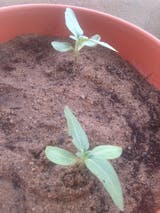


Product Description - Organic Sunflower Seeds - Hybrid
Helianthus is an annual herb with a rough hairy stem that grows 3 to 15 feet tall and broad, coarsely toothed, rough leaves that are 3 to 12 inches long and spiraled.The attractive flower heads range in size from 7.5 to 15 cm in diameter. The petallike ray flowers are yellow, while the disk flowers are brown, yellow, or purple.The common sunflower is valuable both economically and in terms of ornamentation. Hybrid sunflowers have disease resistance.Sunflower seeds are particularly high in vitamin E and selenium, both of which are essential in the treatment of a variety of chronic diseases.
Benefits/Uses of Sunflower
- Sunflower seeds are widely used as garnishes or ingredients in a variety of recipes, as a snack, or sprouted and added to salads.
- Sunflower seeds can also be used to extract oil, which can then be used in cooking.
- The oil is also used as a lubricant and in soaps and paints.
- Sunflower leaves may be used as a source of food for animals. Sunflowers may be used to produce yellow dye.
- They're high in beneficial plant chemicals, healthy fats, and vitamins and minerals. These nutrients can help to lower your risk of developing common health problems like heart disease and type 2 diabetes.
- Sunflowers can be used in phytoremediation to eliminate radioactive elements from soil, such as lead, arsenic, and uranium, and in rhizofiltration to remove radionuclides and other toxic elements, as well as harmful bacteria, from water.
Specifications of Sunflower Seeds
|
Common name |
Sunflower |
|
Sunlight |
Atleast 6 hours to 8 hours everyday |
|
Water |
1 inch per week |
|
Temperature |
Between 55- and 60-degrees Fahrenheit |
|
Soil |
Fast draining alkaline soil |
|
Fertilizer |
Well composted manure, 10-15-10 |
|
Germination |
7 to 14 days |
|
Harvest season |
70 to 100 days |
| No. of seeds | 15 |
Planting and Care for Sunflower
Sowing Sunflower Seeds
- To ensure good contact between the seed and the soil, poke a hole in the growing medium such as grow bags at a depth of about 1 inch or twice the length of the sunflower seed, then cover it with soil and pat it firmly to ensure good contact between the seed and the soil.
- The seeds will sprout out of the ground after 7 to 14 days.
- When sunflower seeds are sprouted, their plant compounds increase, and factors that can obstruct mineral absorption are reduced.
Growing Sunflower
- Sunflower roots have a wide range and can survive drought. Watering the sunflower plants on a regular basis during their most critical growth time, which is around 20 days before and after flowering, is recommended.
- To prevent overcrowding, leave about 1 to 2 feet between and plant. Spreading a 2- or 3-inch layer of organic material on the soil can minimize evaporation and deter weeds.
- Flower heads will appear about 33 days after germination. The anthers, which are the pollen-bearing sections of the plants, grow over an eight-day period after 27 days.
- It will only take another 30 days for the sunflower plant to reach full maturity after this stage.
- Fertilize sunflowers with nitrogen to support the plant's overall growth as well as its height. The nutrient combination given to the plant should be 10-15-10.
Harvesting Of Sunflower
- When the seeds are plump and grown, the flower petals begin to dry out and fall down, and the back of the flower changes color from green to yellow, it is time to harvest. After 70 days of planting, harvesting is possible.
- After the flower petals have fallen, shield the sunflower seeds from birds by wrapping cheesecloth or a paper sack around each sunflower head.
- To extract seeds from the head, loosen them by hand. Harvest by cutting the stalk about 4 inches below the head. Up to 2,000 seeds can be found in a single sunflower head.
Precautions while Growing Sunflower
- Sunflowers that receive enough sunlight grow a large number of blooms that rotate during the day to face the sun because they are such sunseekers. Every day, sunflowers need at least 6 hours of direct, unfiltered sunlight.
- A soil test should be performed to ensure that the pH of the soil is between 6 and 7.5, which is the optimal range for sunflowers.
Common Problems affecting Sunflower Plants and their Solutions
The plants need to be watered on a regular basis, but overwatering or prolonged periods of wet weather may cause diseases like botrytis, which causes the flowers to rot.
Downy mildew, rust, Phomopsis stem canker, Sclerotinia wilt, Verticillium wilt, and charcoal rot are the most common diseases that affect sunflower plants. Some cultural practices, fungicides, and seed treatment may help to reduce the impact of these diseases.
Spraying a general garden fungicide like Pseudomonas Fluorescens Bio Fertilizer, Trichoderma Viride Bio Fertilizers as guided and in the appropriate amount will protect healthy foliage if fungal diseases are detected early. Plants that are severely contaminated should be removed and destroyed.
Overfertilization should be avoided. When a plant is exposed to large quantities of fertilizer, the leaves may burn and the plant will die.
No. of Sunflower Seeds - 15















